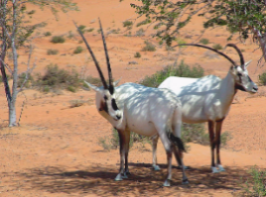
The files on this site are for the Version 1.0 draft assembly of the Arabian oryx (Oryx leucoryx) genome generated by whole genome shotgun next-generation sequencing.
Using the sequence provided here assumes you agree to not publish whole genome based analysis of this data without our consent. For more information please contact Joel A. Malek at
jom2042@qatar-med.cornell.edu
Highlights include: a predicted genome size of ~3Gb (similar to other Mammals), a scaffold N50 of ~300kb, an assembly spanning ~2.5Gb of the genome which is likely >90% of euchromatic sequence. The sequence is distributed across 36,964 scaffolds greater than 500bp. We detected ~1M SNPs between parental alleles which is significantly fewer than in other mammals. Further genome sequencing of other oryx will be required to determine whether this is indicative of oryx worldwide; suggesting the bottleneck of near extinction severely reduced genetic diversity, or whether this is only the case in certain oryx herds.
It is our hope that the results provided here will be a starting point for researchers doing genetic studies on the oryx. The assembly is a draft assembly using next generations sequencing reads and requires caution in usage. While short range contiguity is of high quality, longer range contiguity is less certain. Our inspection of the scaffolds has shown good synteny with other sequenced bovidae genomes.
The Arabian oryx was hunted to near extinction in the 1950s-1970s. The oryx was then placed on the "Endangered" list and ranks among the rarest mammals in the world. Due to excellent captive breeding and reintroduction programs, in 2011, the oryx was moved to "Vulnerable" with a world wide population of ~7000. Qatar currently has ~800 oryx and has donated numerous oryx to breeding programs around the world. As such, Qatar may be a significant source of genetic diversity to the world-wide oryx population. The oryx presently available are likely descended from very few ancestors causing a very tight genetic bottleneck in the population. We provide the Single Nucleotide Polymorphism data in hopes it can be used for improving breeding strategies by maintaining as much genetic diversity as possible.
June 3, 2012 Weill Cornell Medicine - Qatar (WCM-Q) Genomics Core:
Eman K. Al-Dous, Eman K. Al-Azwani, Binu George, Yasmeen M.Salameh, Yasmin A. Mohamoud, and Joel A. Malek
and Biotechnology Centre of the Ministry of Environment (Mr. Massoud Jarallah Al Marri, Director):
Ameena A. Al-Malki
DNA was kindly provided from a male oryx by:
Atef Sayed and Benjamin Shykind (Shykind Group - WCM-Q)
Wabra Wildlife Preservation (Qatar)